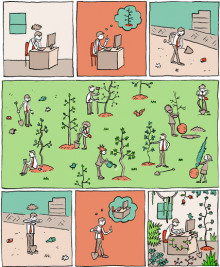
First the good news: More Americans volunteer their time and talent for good causes across a wide spectrum. Now the bad news: Though much of this volunteerism is driven by the fact that the majority of Americans are blessed with relative material abundance, the roots of these willingness to volunteer outside of the workplace is driven by another factor, and a frightening one – Americans are more disengaged from their jobs than at any time in our history.
I had a vague notion that this was the case, but it hit home for me dramatically when I read Aaron Hurst’s New York Times piece, “Being Good Isn’t the Only Way to Go.” Here is part of what he said:
“This demand to volunteer masks a broader problem in our society. It points to the lack of purpose that we experience in our jobs. As Jessica B. Rodell, a professor at the University of Georgia, has found in her research, “when jobs are less meaningful, employees are more likely to increase volunteering to gain that desired sense of meaning.” The numbers speak for themselves. In a recent Gallup poll, 70 percent of American workers said they were not engaged with their jobs, or were actively disengaged.”
“But if people are finding satisfaction in self-expression and personal growth, as well as teamwork, then that suggests that they don’t have to search outside of work for meaning. Because it wasn’t the nonprofit’s larger goals that gave them meaning; it was the way they performed their work. And research confirms that it is possible for many people to find purpose in work, primarily through making a choice about how to approach it. Having a purpose isn’t necessarily about what a company makes or sells, but rather, it’s about how the workers approach their day.”
“Companies such as Cornerstone Capital Group have begun to adopt changes to increase employee purpose. Erika Karp, the chief executive, told me that she asked her employees whether they had a good day and to identify moments that made it so. She then works with them to refine their job, making small adjustments to change their engagement at work and boost their meaning. This is an even greater imperative with young people. In a 2011 report by Harris Interactive, commissioned by the Career Advisory Board, meaning was the top career priority for those between the ages of 21 and 31.”
Want more? You can read the full article here.

There is so much dreadful news leaping out of our phones, tablets or our television sets every day. For many of us, it’s easy to get overwhelmed by the bad news and let yourself think there is nowhere to turn for good news.
Maybe that’s because we let our lens get too narrow. And truth-be-told, not all of us have the kind of job where we get paid to explore the world around us and see what is good and what’s not so good.
Nicholas Kristof of the New York Times does have the kind of job where he can look around and make that kind of assessment. That’s what drew me to his op-ed: “Good News, Despite What You’ve Heard.” Here is part of what he shared:
Cheer up: Despite the gloom, the world truly is becoming a better place. Indeed, 2017 is likely to be the best year in the history of humanity.
Perhaps the optimism doesn’t feel right. You’re alarmed by President Trump (or Nancy Pelosi), terrorism and the risk of rising seas, if we’re not first incinerated by North Korean nukes. Those are good reasons for concern, but remember that for most of history humans agonized over something more elemental: Will my children survive?
Just since 1990, more than 100 million children’s lives have been saved through vaccinations and improved nutrition and medical care. They’re no longer dying of malaria, diarrhea or unpleasant causes like having one’s intestines blocked by wriggling worms. (This is a good news column, but I didn’t say it wouldn’t be a bit gross.)
Want more? You can read the full article here.
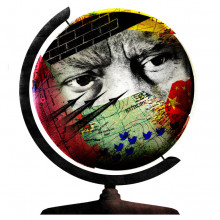
A recent op-ed about North Korea, jointly authored by Secretary of State Rex Tillerson and Secretary of Defense James Mattis, put an exclamation point on fact that, for the United States, as well as for most nations, foreign policy success, is to have diplomats and military officers, work hand-in-hand to ensure the security and prosperity of the United States.
That’s why I was intrigued by two recent companion New York Times articles: “The Diplomats Can’t Save Us,” and “The Generals Can’t Either.” Together they paint a challenging picture for the future of United States foreign policy. Both articles deserve a full-read by all of us. A few highlights to whet your appetite:
From “The Diplomats Can’t Save Us:”
The president signaled early on that military might, not diplomatic deftness, was his thing. Soft power was for the birds. This worldview (in essence no more than Trump’s gut) has been expressed in a proposed cut of about 30 percent in the State Department budget as military spending soars; a push to eliminate some 2,300 jobs; the vacancy of many senior posts, including 20 of the 22 assistant secretary positions requiring Senate confirmation; unfilled ambassadorships — roughly 30 percent of the total — from Paris to New Delhi; and the brushoff of the department’s input in interagency debate and in pivotal decisions, like withdrawal from the Paris climate accord. Days are now marked by resignations, unanswered messages and idled capacity.
From “The Generals Can’t Either:”
During a recent conference in Singapore, someone asked Secretary of Defense James Mattis whether, given President Trump’s withdrawal from the Trans-Pacific Partnership and the Paris climate agreement, we were “present at the destruction” of the America-led postwar order. In a twist on a remark by Abba Eban (often attributed to Churchill), the former general answered: “Bear with us. Once we have exhausted all possible alternatives, the Americans will do the right thing.”
Read more of these two revealing articles here, and here.
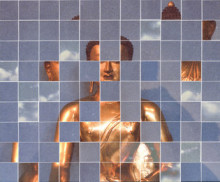
Two weeks ago, I blogged on an article by Robert Wright, “The Meditation Cure.” Here is how he began:
Much of Buddhism can be boiled down to a bad-news/good-news story. The bad news is that life is full of suffering and we humans are full of illusions. The good news is that these two problems are actually one problem: If we could get rid of our illusions—if we could see the world clearly—our suffering would end.
Yesterday, in a review of Robert Wright’s new book, “Why Buddhism is True,” Antonio Damasio had this to say about Wright’s book, and more broadly, on whether Buddhism practices can lead to healthier individuals and communities:
My take on Wright’s fundamental proposals is as follows:
- First, the beneficial powers of meditation come from the possibility of realizing that our emotive reactions and the consequent feelings they engender — which operate in automated fashion, outside our deliberate control — are often inappropriate and even counterproductive relative to the situations that trigger them.
- Second, the mismatch between causes and responses is rooted in evolution. We have inherited from our nonhuman and human forerunners a complex affect apparatus suited to life circumstances very different from ours. That apparatus — which is controlled from varied sectors of our nervous systems — was created by natural selection and assisted by genetic transmission over a long period of time. It worked well for nonhuman primates and later for human hunter gatherers, but it has worked far less well as cultures became more complex.
- Third, meditation allows us to realize that the idea of the self as director of our decisions is an illusion, and that the degree to which we are at the mercy of a weakly controlled system places us at a considerable disadvantage.
- Fourth, the awareness brought on by meditation helps the construction of a truly enlightened humanity and counters the growing tribalism of contemporary societies.
Want more? You can read the full article here.

Not many of us associate the two words “leadership” and “solitude.” That’s why I was intrigued by a review of the new book, “Lead Yourself First.” The essence of the review is that leaders need solitude to have the chance to “percolate” and “marinate” in his or her own feelings and to step out of events and locate the sacred space where he or she can reflect on what’s going on inside himself, thus attaining the moral and emotional conviction necessary to act.
In the review, Andrew Stark makes many interesting points, saying, for example:
Former Campbell Soup CEO Doug Conant runs into it in his garden. For entrepreneur Sarah Dillard, it’s to be found when she’s hiking. Tim Hall, a cycling coach, grabs some of it while gazing out at his bird feeder over coffee every morning. The pastor Jimmy Bartz encounters it while fly fishing.
What they are discovering, as Raymond M. Kethledge and Michael S. Erwin report in “Lead Yourself First,” is solitude, a vitally necessary but all too scarce commodity for organizational leaders. It’s scarce because, even more than the rest of us, leaders get bombarded 24/7 by attention-demanding memos, tweets, texts, emails, phone calls, videoconferences and hallway button-holings.
It’s necessary because only with some alone-time can leaders hope to gain a “sense of control” over all that incoming information, as communications officer Jaya Vadlamudi tells the authors. Only by herself, she says, can she hope to “whittle” such stimuli down to the essentials and reach clarity. Or as the Schwab executive Peter Crawford puts it: Solitude makes it possible to engage in the mental equivalent of “stripping away all the cookies on a computer. Once they’re cleared, my mind works better.”
Read more of this revealing article here.
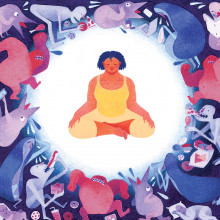
Buddha meet Charles Darwin. This initially may seem to be an odd pair to put together, but not according to a recent article by Robert Wright, “The Meditation Cure.” Here is how he begins:
Much of Buddhism can be boiled down to a bad-news/good-news story. The bad news is that life is full of suffering and we humans are full of illusions. The good news is that these two problems are actually one problem: If we could get rid of our illusions—if we could see the world clearly—our suffering would end.
And there’s more good news: Buddhism offers tools for doing that job. A good example is the type of meditation known as mindfulness meditation, now practiced by millions of people in the U.S. and other places far from Buddhism’s Asian homeland. Mindfulness meditation, Buddhists say, can change our perspective on feelings such as anxiety and rage and thereby sap their power to warp our vision and make us suffer.
These claims—the bad news and the good—are more than two millennia old, but they’re now getting important support from evolutionary psychology, the modern study of how natural selection engineered the human mind. Evolutionary psychology gives Buddhism’s diagnosis of the human predicament a back story. It explains why humans are prone to illusions and to suffering and why the two problems are related. And this explanation can strengthen the Buddhist prescription, adding to the power of mindfulness meditation in particular.
Mindfulness meditation is an exercise in attention. It involves calming the mind—typically by focusing on the breath—and then using the resulting equanimity to observe things with unusual care and clarity. The things observed can include sounds, physical sensations or anything else in the field of awareness. But perhaps most important is the careful observation of feelings, because feelings play such a powerful role in guiding our perceptions, thoughts and behavior.
Want more? You can read the full article here.

There are years that are watershed years, times where just extrapolating the present into the future isn’t enough.
For most of us, these years come and go and only in hindsight so we put it all together and take stock about what just happened.
It wasn’t until I read Tom Friedman’s article, “Dancing in a Hurricane,” that I was able to reflect that 2007 was such a year. Here is part of what he said:
What the hell happened in and around 2007? 2007? That’s such an innocuous year. But look again.
Steve Jobs and Apple released the first iPhone in 2007, starting the smartphone revolution that is now putting an internet-connected computer in the palm of everyone on the planet. In late 2006, Facebook, which had been confined to universities and high schools, opened itself to anyone with an email address and exploded globally. Twitter was created in 2006, but took off in 2007. In 2007, Hadoop, the most important software you’ve never heard of, began expanding the ability of any company to store and analyze enormous amounts of unstructured data. This helped enable both Big Data and cloud computing. Indeed, “the cloud” really took off in 2007.
In 2007, the Kindle kicked off the e-book revolution and Google introduced Android. In 2007, IBM started Watson — the world’s first cognitive computer that today can understand virtually every paper ever written on cancer and suggest to doctors highly accurate diagnoses and treatment options. And have you ever looked at a graph of the cost of sequencing a human genome? It goes from $100 million in the early 2000s and begins to fall dramatically starting around … 2007.
Read more of this short – but revealing – article here.

Many of us “of a certain age” recall school as a journey of memorization. Whether it was the table of elements, mathematical formulas, or the dates of historic events, paraphrasing the Nike ad, we “just did it.”
That has changed dramatically and from their earliest days of schooling, today’s kids figure they can just “Google it,” to uncover literally anything they want to know. Can we now just give oer brains a rest? Not so fast.
I was intrigued by an article in the New York Times entitled “You Still Need Your Brain.” Here is part of what it said:
Google is good at finding information, but the brain beats it in two essential ways. Champions of Google underestimate how much the meaning of words and sentences changes with context. Consider vocabulary. Every teacher knows that a sixth grader, armed with a thesaurus, will often submit a paper studded with words used in not-quite-correct ways, like the student who looked up “meticulous,” saw it meant “very careful,” and wrote “I was meticulous when I fell off the cliff.”
With the right knowledge in memory, your brain deftly puts words in context. Consider “Trisha spilled her coffee.” When followed by the sentence “Dan jumped up to get a rag,” the brain instantly highlights one aspect of the meaning of “spill” — spills make a mess. Had the second sentence been “Dan jumped up to get her more,” you would have thought instead of the fact that “spill” means Trisha had less of something. Still another aspect of meaning would come to mind had you read, “Dan jumped up, howling in pain.”
Read the full article here.
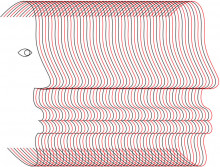
Mindfulness and mindfulness meditation have been around for a while now, with more and more practitioners finding value in living in the moment, not dwelling on the past or worrying about the future. As one convert put it, “I don’t want to get to the end of my life and find out I didn’t show up for it. The mindfulness movement is growing, both in our personal lives as well as in the workplace.
Some wonder why mindfulness hasn’t caught fire more rapidly. I wondered too, before I read an interesting piece in the New York Times entitled, “We Aren’t Built to Live in the Moment.” The writers lay out a good case for why we don’t embrace mindfulness more enthusiastically, and it goes directly to what makes us human. Here’s part of what they say:
What best distinguishes our species is an ability that scientists are just beginning to appreciate: We contemplate the future. Our singular foresight created civilization and sustains society. It usually lifts our spirits, but it’s also the source of most depression and anxiety, whether we’re evaluating our own lives or worrying about the nation. Other animals have springtime rituals for educating the young, but only we subject them to “commencement” speeches grandly informing them that today is the first day of the rest of their lives.
A more apt name for our species would be Homo prospectus, because we thrive by considering our prospects. The power of prospection is what makes us wise. Looking into the future, consciously and unconsciously, is a central function of our large brain, as psychologists and neuroscientists have discovered — rather belatedly, because for the past century most researchers have assumed that we’re prisoners of the past and the present.
You can read this interesting article here.

We all likely belong to one or more institutions. Some belong to many. I’d always wondered why I “stuck” with and to some institutions, while others faded out.
I wondered, that is, until I read David Brooks piece called, “How to Leave a Mark on People.” Here is part of what he said:
Some organizations are thick, and some are thin. Some leave a mark on you, and some you pass through with scarcely a memory. Which raises two questions: What makes an institution thick? If you were setting out consciously to create a thick institution, what features would it include?
A thick institution is not one that people use instrumentally, to get a degree or to earn a salary. A thick institution becomes part of a person’s identity and engages the whole person: head, hands, heart and soul. So thick institutions have a physical location, often cramped, where members meet face to face on a regular basis, like a dinner table or a packed gym or assembly hall.
Thin institutions tend to see themselves horizontally. People are members for mutual benefit. Thick organizations often see themselves on a vertical axis. People are members so they can collectively serve the same higher good.
In the former, there’s an ever-present utilitarian calculus — Is this working for me? Am I getting more out than I’m putting in? — that creates a distance between people and the organization. In the latter, there’s an intimacy and identity borne out of common love. Think of a bunch of teachers watching a student shine onstage or a bunch of engineers adoring the same elegant solution.
What about your institutions?
Want more? Read the full article here.











